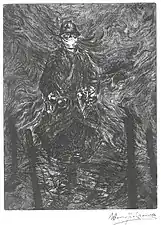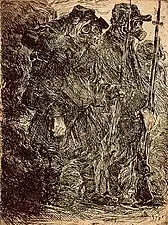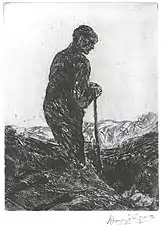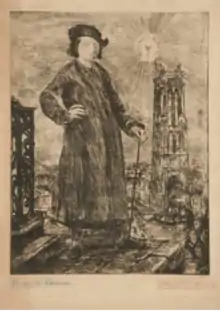Henry de Groux
Henry de Groux (15 September 1866, Brussels – 12 January 1930, Saint-Josse-ten-Noode)[1] was a Belgian Symbolist painter, sculptor and lithographer. His 1889 painting Christ attacked by a mob made when he was only 22 years old established his reputation as an innovative Symbolist painter and ensured his admission to the progressive artistic circles in Brussels.[2] He spent most of his active career in Paris. He produced many works depicting the horrors of the First World War in the latter part of his career.
Henry de Groux | |
|---|---|
%252C_pencil%252C_Indian_ink%252C_pen%252C_wash_on_paper%252C_34.3_x_25.5_cm.%252C_Royal_Museums_of_Fine_Arts_of_Belgium%252C_Brussels.jpg.webp) Portrait of Henry de Groux by William Degouve de Nuncques | |
| Born | September 15, 1866 |
| Died | January 12, 1930 (aged 62) |
| Known for | Painting |
| Movement | Symbolism |
Life
De Groux was the son of the painter and engraver Charles de Groux. Like his father, he trained at the Académie Royale des Beaux-Arts in Brussels. Henry was elected a member of les XX in 1886, but was expelled in 1890 when he refused to have his works displayed in the same gallery as Vincent van Gogh. He shared a studio with the Belgian painter William Degouve de Nuncques for a time in the 188os.[3]:230
De Groux subsequently moved to Paris, where he befriended Émile Zola. During the social unrest resulting from the Dreyfus affair, de Groux acted as one of Zola's bodyguards. In Paris he also rubbed shoulders with other artists such as Toulouse-Lautrec, Whistler, Gauguin, Ensor, Rodin and Debussy. He also frequented many writers, including his future son-in-law Emile Baumann, Stéphane Mallarmé, Guillaume Apollinaire, Oscar Wilde, Léon Bloy - with whom he maintained a fusional friendship - Verlaine, Zola, Heredia, Gide, Milosz, Remy de Gourmont and Joris-Karl Huysmans.
Henri de Groux exhibited all over Europe at the salons of Paris, Brussels, Ostend, Spa, Amsterdam, London and Florence. In the latter places he was interned in a psychiatric hospital. He escaped from it and walked all the way to back to Marseille.
He illustrated various literary works. He contributed lithographs to L'Estampe originale (1893) and L'Épreuve (1895).
De Groux had a reputation of a bohemian living a wild and disorderly life. In the preamble of Léon Bloy's book La Femme pauvre (The Poor Woman) de Groux is described as follows : With the exception of our great painter Henry de Groux, who has descended as deeply as you and as heartily into my black pit? (La Part Commune Edition, 1897).[4]
His elder daughter Elisabeth de Groux was an engraver. She married Emile Baumann who after his father in laws business write a revealing biography[5] titled The terrible life of Henry de Groux.[6]
Work
As well as a painter, de Groux was a fervent diarist. Starting from 1892, he produced 18 volumes detailing his life as a European artist in the late 19th and early 20th centuries. In 2002, his descendants donated these volumes to the Institut national d'histoire de l'art; selected excerpts were published in 2007.[7][8]
Apollinaire wrote of De Groux's exhibition in Paris at the Salon d'Automne 1911, praising with "...gives one the impression of an immense labor and a sensibility of the highest order..."
Gallery
Paintings
.JPG.webp) Christ Attacked by a Mob (1889), oil on canvas,
Christ Attacked by a Mob (1889), oil on canvas,%252C_oil_on_canvas%252C_90_x_83_cm.%252C_private_collection.jpg.webp) Bacchanal (date unknown), oil on canvas, 90 x 83 cm., private collection
Bacchanal (date unknown), oil on canvas, 90 x 83 cm., private collection%252C_oil_on_canvas%252C_75_x_104_cm.%252C_private_collection.jpg.webp) The Barque of Don Juan (date unknown), oil on canvas, 75 x 104 cm., private collection
The Barque of Don Juan (date unknown), oil on canvas, 75 x 104 cm., private collection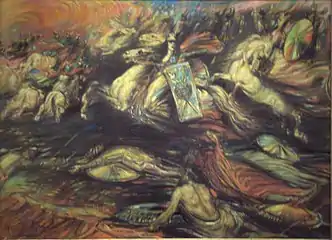 Ride of the Valkyries (ca. 1890), Royal Museums of Fine Arts of Belgium, Brussels
Ride of the Valkyries (ca. 1890), Royal Museums of Fine Arts of Belgium, Brussels%252C_oil_on_canvas%252C_76_x_98_cm.%252C_private_collection.jpg.webp) The Great Upheaval (1893), oil on canvas, 76 x 98 cm., private collection
The Great Upheaval (1893), oil on canvas, 76 x 98 cm., private collection Zola Insulted (1898), oil on canvas, 81 x 109,5 cm., private collection
Zola Insulted (1898), oil on canvas, 81 x 109,5 cm., private collection%252C_oil_on_canvas%252C_118_x_148_cm.%252C_private_collection.jpg.webp) The Death of Siegfried (1899), oil on canvas, 118 x 148 cm., private collection
The Death of Siegfried (1899), oil on canvas, 118 x 148 cm., private collection The Grotto (c. 1900), demotions unknown
The Grotto (c. 1900), demotions unknown%252C_oil_on_canvas%252C_demotions_unknown%252C_private_collection.jpg.webp) Figures at a Ball (c. 1902), oil on canvas, demotions unknown, private collection
Figures at a Ball (c. 1902), oil on canvas, demotions unknown, private collection Portrait of James Ensor (1907), oil on canvas, Mu.ZEE, Ostend
Portrait of James Ensor (1907), oil on canvas, Mu.ZEE, Ostend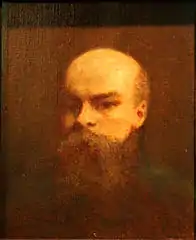 Portrait of Paul Verlaine (date unknown), oil on canvas, 46 x 38 cm., Royal Museums of Fine Arts of Belgium, Brussels
Portrait of Paul Verlaine (date unknown), oil on canvas, 46 x 38 cm., Royal Museums of Fine Arts of Belgium, Brussels The Death of Andronicus (1926), Fin-de-Siècle Museum (French: Musée Fin-de-Siècle, Brussels
The Death of Andronicus (1926), Fin-de-Siècle Museum (French: Musée Fin-de-Siècle, Brussels
Prints and graphics
Notes
- "Colours of the War: Art Work of Belgian Soldiers at the Front (1914–1918): A Selection of the Collections kept at the Royal Army Museum in Brussels; published 2000; ISBN 2-87051-027-6; page 57
- Rodolphe Rapetti, Un chef-d'oeuvre pour ces temps d'incertitude: Le Christ aux outrages d'Henry de Groux, in: Revue de l'Art Année 1992 96 pp. 40–50 (in French)
- Delevoy, Robert L. (1978) Symbolists and Symbolism. Skira/Rizzoli International Publications, Inc., New York, 230 pp. ISBN 0-8478-0141-1
- Pinchon.html Pierre Pinchon, Autoportrait d'Henry De Groux en “héros mendiant”, in: Image de l'artiste, sous la direction d'Éric Darragon et Bertrand Tillier, Territoires contemporains, nouvelle série - 4 (in French)
- Bollery, Joseph (1954). Léon Bloy: Essai de Biographie, Avec de Nombreux Documents Inédits (in French). Albin Michel.
- Baumann, Emile (1936). La vie terrible d'Henry de Groux (in French). B. Grasset.
- Henry de Groux 1866–1930 - journal - Henry De Groux, Rodolphe Rapetti, Pierre Wat - Editions Kimé at www.dessinoriginal.com
- Publication : Henry de Groux 1866–1930, Journal at www.latribunedelart.com
External links
 Media related to Henry de Groux at Wikimedia Commons
Media related to Henry de Groux at Wikimedia Commons
%252C_RP-P-1967-1045.jpg.webp)
